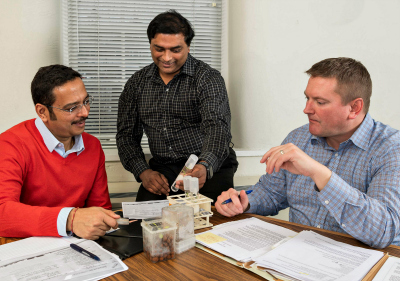The field on the left has been treated with a BASF inoculant containing the UD-patented beneficial bacteria named UD1022. Inset: Bacteria rapidly cover newly formed root tissue, helping to shelter it from stresses associated with growth in soil. Teaser photo of roots courtesy BASF research trials 2017.
Our global population is growing, and more people means more mouths to feed. Farmers confront this problem every day, searching for ways to increase food production while safeguarding their crops.
At the University of Delaware, basic research aimed at providing safe, effective tools for agricultural growers led to the discovery of a beneficial microbe that helps increase plant size and yields, improve drought tolerance and fight fungal disease.
Developed by Professors Harsh Bais and Janine Sherrier, the UD-patented microbe [known as UD1022] is a unique strain of Bacillus subtilis, a natural, beneficial bacterium that lives on the surface of roots and the surrounding soil, or rhizosphere. Studies show that the beneficial microbe helps boost the protection of seedlings and plants from disease. It also helps plants form a root-strengthening biofilm, allowing more energy to be directed to growth and yield.
BASF, a global company that creates chemistry for a sustainable future, recognized the technology’s potential for improving crop productivity and worked with UD’s technology transfer office to license the UD-discovered microbe in 2013.
Today the UD technology is a key component of BASF’s Velondis product line. In early 2018, BASF introduced a rhizobial-based inoculant for peas and lentils called Nodulator Duo that incorporates the UD-patented Bacillus subtilis strain in conjunction with BASF’s top performing rhizobial strain for pea and lentil. The product is used in Canada to promote nitrogen fixation and plant health in peas and lentils.
BASF is currently exploring other ways to use the UD-patented microbe for other agricultural crops, including soybean and corn. The promising microbe may have other potential applications in horticulture and forestry, too. At UD, Bais and colleague Yan Jin have shown that a strain of the beneficial microbe can increase water retention in
soil to mitigate drought. Bais also is studying the beneficial microbe’s effect on alfalfa.
UD's Office of Economic Innovation and Partnership has been instrumental in our success....they really stepped up to help us convert a simple, basic science idea into an extremely important and timely commercial product for the agricultural market.
Harsh Bais
The path to commercialization
Sherrier and Bais did not arrive at commercialization on their own. UD’s
Office of Economic Innovation and Partnerships (OEIP) played a significant role in helping the researchers navigate the various aspects of the process.
It was basic research that led to the discovery of UD1022’s ability to help plants fight fungal disease. When Sherrier, then a UD scientist, realized they might have something important, she reached out to OEIP for support in evaluating whether the innovation had market potential.

The diverse team at OEIP’s Technology Transfer Center reviewed the innovation and determined that UD1022 was both patentable and had solid commercial potential. The technology transfer team helped the researchers acquire the proper legal protection and find a partner (Becker Underwood, now BASF) to test the invention and collect preliminary performance data. They then negotiated a two-year research contract with BASF in 2011, allowing Sherrier and Bais to validate the invention’s usefulness over a broad range of applications. An exclusive licensing agreement with BASF followed, and — fast forward to 2018 — has resulted in a real product.
“Technology transfer involves the transitioning of scientific findings from the University to an industry partner with the aim of developing the invention and commercializing it into a product,” said Joy Goswami, assistant director of technology transfer at UD and a member of AUTM’s Cabinet. “This process involves identifying the technology, safeguarding it with patents or other types of intellectual property protection, and licensing those rights to industry.”
The work is complex and requires tech transfer professionals to be fluent in the specialized languages used by scientists, engineers, business professionals and lawyers. They have to be patient, nimble and considerate of all stakeholders and keep everyone informed during the process. Behind the scenes, there are myriad tasks and mounds of paperwork to keep the process moving forward.
For faculty members like Bais, though, having the tech transfer folks in OEIP in his corner is a major advantage; one that allowed the researchers to continue focusing on the science.
“OEIP has been instrumental in our success,” Bais said. “Early on, they provided seed money to fund a student to work on this project full time doing greenhouse trials using UD1022 on different plants and plant combinations. Later, having a team of tech transfer professionals who understand the science, was extremely helpful to our formulating ideas and concepts into logical products. In this way, OEIP really stepped up to help us convert a simple, basic science idea into an extremely important and timely commercial product for the agricultural market.”
This story was originally published in 2019.
To see available technologies from research institutions, click here to visit the AUTM Innovation Marketplace.